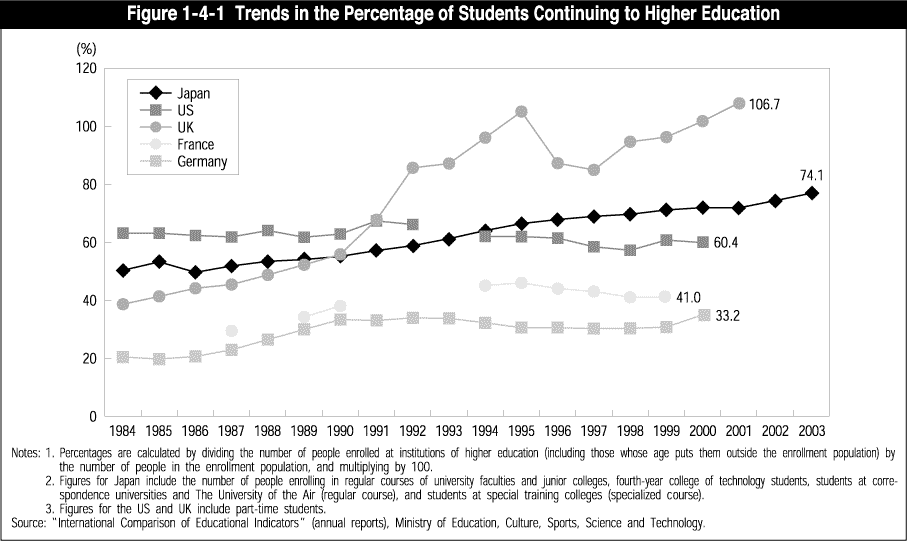| Home > Policy > White Paper, Notice, Announcement > White Paper > FY2003 White Paper on Education, Culture, Sports, Science and Technology >Part1 Chapter4 Section1 | ||
The 21st century is being called a century of a knowledge-based society, a century of countries using their knowledge, information and technological capabilities to engage in fierce economic competition on a global scale. All of the countries covered in this chapter (the US, European countries, China, and the ROK) are expecting more than ever from their universities in terms of cultivating human resources who will carve out the path to the era of knowledge and advanced research activities, and who are actively pushing towards reforms.
The higher education reform by these countries shares both a common historical backdrop and to a certain extent, a common direction in the aspired shape of higher education. We can use the words "expansion" and "competition" to describe this situation.
Japan and the US have achieved dissemination and expansion of higher education relatively early. In particular, at the beginning of the 1980s, the amount of American students continuing to higher education reached the 60-percent range. The UK, France and the ROK, which had been lagging behind, began to expand in the late 1980s. Now some of them boast percentages that surpass those of both the US and Japan. The so-called "popularization" and "universalization" of higher education are being achieved in many countries ( Figure 1-4-1 ).
Now that it has grown to large proportions, higher education in each country is confronted by the issue of quality. As not only students and teachers, but also institutions of higher educations grow more diverse, each country is tackling various reforms to maintain quality and make improvements in higher education. Although there are different situations in each country, there is a common method to their reform efforts: the formation of a competitive environment. It may be said that in the US, a system wherein state universities operate independently as corporations that compete with each other to acquire students and research funds has already been formed historically. In contrast, countries that had strong control and protection of their universities, such as the UK, France and Germany as well as China and the ROK, have made a shift and are now promoting reforms that allow universities to develop diverse and distinctive education and research that addresses the demands of students and society, under deregulation and the expansion of universities' discretionary powers. In addition, evaluation of universities is always combined with deregulation. It is hoped that through evaluation, instructions for improvement will be given and the vitality of universities will be tapped through the reflection of evaluation results in budget allocations.
At the same time, separate from these developments, economic integration of the European Union (EU) is progressing and a wide-ranging labor market is forming. Moves to address this situation can be seen in France, Germany and the other EU countries in the form of efforts to change the higher education systems that have developed uniquely in each country, including the introduction of a common degree system. The formation of such common frameworks will be the foundation for encouraging competition.
Moreover, expansion and competition are prompting new developments in higher education funding. In the countries of Europe and China, where the national and provincial governments had provided the main support, the increasing financial burden accompanying expansion can no longer be borne solely by public finances. The UK and China have completely shifted from free systems to paid tuition systems, Germany has made a partial switch to paid tuition, and other countries now require students to bear the cost of higher education in some form. However, some countries, like France, are endeavoring to cover the mounting costs of higher education with public finances.
All countries nevertheless share common policies that aim to utilize limited public funds effectively. Aside from the policy to reflect university evaluation results in budget allocations mentioned earlier, the utilization of competitive funds has also important implications. In particular, concentrated investment in specific universities aimed at the development of world-class universities in China, and the ROK has similarities to Japan's Center of Excellence (COE) policies (see Part I, Chapter 2,Section 4 ).
The following sections will take a country-by-country look at developments in higher education in each country from three standpoints: 1) an expansion of scale and opportunities; 2) maintaining and improving quality and vitalization; and 3) a change in fiscal policy.

| Back To Top | MEXT HOME |